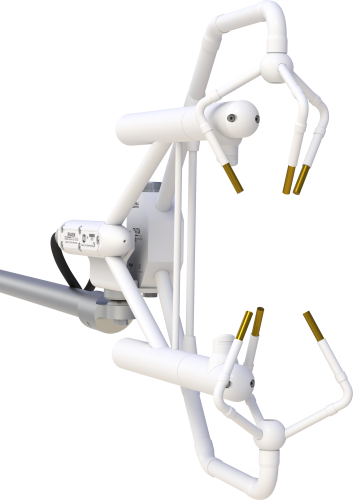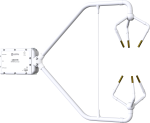
Uso como parte de un sistema eddy-covariance open-path o como IRGA autónomo






Resumen
El EC150 de Campbell Scientific es un analizador open-path especialmente diseñado para medida de flujos eddy-covariance (covarianza torbellinos). Como analizador autónomo, mide simultáneamente densidades absolutas de dióxido de carbono y vapor de agua, temperatura del aire y presión barométrica. Junto con el cabezal anemómetro sónico CSAT3A (opcional), el EC150 mide también el viento en tres dimensiones y la temperatura del aire (sónica).
Leer másVentajas y características
- New conformal coating helps protect sonic transducers in corrosive environments
- Unique optical configuration gives a slim aerodynamic shape with minimal wind distortion
- Analyzer and sonic anemometer measurements are synchronized by a common set of electronics
- Maximum output rate of 60 Hz with 20 Hz bandwidth
- Low power consumption; suitable for solar power applications
- Low noise
- Measurements are temperature compensated without active heat control
- Angled windows to shed water and are tolerant to window contamination
- Field rugged
- Field serviceable
- Factory calibrated over wide range of CO2, H2O, pressure, and temperature in all combinations encountered in practice
- Extensive set of diagnostic parameters
- Fully compatible with Campbell Scientific dataloggers; field setup, configuration, and field zero and span can be accomplished directly from the datalogger
- Speed of sound determined from three acoustic paths; corrected for crosswind effects
- Innovative signal processing and transducer wicks considerably improve performance of the anemometer during precipitation events
Imágenes

Productos similares
Descripción detallada
The CSAT3A has the following outputs:
- Ux (m/s)*
- Uy (m/s)*
- Uz (m/s)*
- Sonic Temperature (°C)*
- Sonic Diagnostic*
The EC150 has the following outputs:
- CO2 Density (mg/m3)
- H2O Density (g/m3)
- Gas Analyzer Diagnostic
- Ambient Temperature (°C)
- Atmospheric Pressure (kPa)
- CO2 Signal Strength
- H2O Signal Strength
- Source Temperature (°C)
*The first five outputs require the CSAT3A Sonic Anemometer Head.
Especificaciones
| Operating Temperature Range | -30° to +50°C |
| Calibrated Pressure Range | 70 to 106 kPa |
| Input Voltage Range | 10 to 16 Vdc |
| Power | 5 W (steady state and power up) at 25⁰C |
| Measurement Rate | 60 Hz |
| Output Bandwidth | 5, 10, 12.5, or 20 Hz (user-programmable) |
| Output Options | SDM, RS-485, USB, analog (CO2 and H2O only) |
| Auxiliary Inputs | Air temperature and pressure |
| Gas Analyzer/Sonic Volume Separation | 5.0 cm (2.0 in.) |
| Warranty | 3 years or 17,500 hours of operation (whichever comes first) |
| Cable Length | 3 m (10 ft) from EC150 and CSAT3A to EC100 |
| Weight |
|
Gas Analyzer |
|
| Path Length |
15.37 cm (6.05 in.)
A temperature of 20°C and pressure of 101.325 kPa was used to convert mass density to concentration. |
Gas Analyzer - CO2 Performance |
|
| -NOTE- | A temperature of 20°C and pressure of 101.325 kPa was used to convert mass density to concentration. |
| Accuracy |
|
| Precision RMS (maximum) |
0.2 mg/m3 (0.15 µmol/mol)
Nominal conditions for precision verification test: 25°C, 86 kPa, 400 μmol/mol CO2, 12°C dewpoint, and 20 Hz bandwidth. |
| Calibrated Range | 0 to 1,000 μmol/mol (0 to 3,000 µmol/mole available upon request.) |
| Zero Drift with Temperature (maximum) | ±0.55 mg/m3/°C (±0.3 μmol/mol/°C) |
| Gain Drift with Temperature (maximum) | ±0.1% of reading/°C |
| Cross Sensitivity (maximum) | ±1.1 x 10-4 mol CO2 /mol H2O |
Gas Analyzer - H2O Performance |
|
| -NOTE- | A temperature of 20°C and pressure of 101.325 kPa was used to convert mass density to concentration. |
| Accuracy |
|
| Precision RMS (maximum) |
0.004 g/m3 mmol/mol (0.006 mmol/mol) Nominal conditions for precision verification test: 25°C, 86 kPa, 400 μmol/mol CO2, 12°C dewpoint, and 20 Hz bandwidth. |
| Calibrated Range | 0 to 72 mmol/mol (38°C dewpoint) |
| Zero Drift with Temperature (maximum) | ±0.037 g/m3/°C (±0.05 mmol/mol/°C) |
| Gain Drift with Temperature (maximum) | ±0.3% of reading/°C |
| Cross Sensitivity (maximum) | ±0.1 mol H2O/mol CO2 |
Sonic Anemometer - Accuracy |
|
| Offset Error |
|
| Gain Error |
|
| Measurement Precision RMS |
|
| Speed of Sound | Determined from 3 acoustic paths (corrected for crosswind effects) |
| Rain | Innovative ultrasonic signal processing and user-installable wicks considerably improve the performance of the anemometer under all rain events. |
Ambient Temperature |
|
| Manufacturer | BetaTherm 100K6A1IA |
| Total Accuracy | ±0.15°C (-30°C to +50°C) |
| EC100 ingress protection | IP65 |
Documentos
Manuales
Documentos técnicos
Misceláneo
- Improved Flux Measurements from Campbell Scientific Open-Path Gas Analyzers: Utilizing Sonic Temperature to Account for Spectroscopic Effects on CO2 Density
- Influence of Open-path Gas Analyzer Flow Distortion on Ultrasonic Wind Measurements
- Using Molecular Sieve to Zero Infrared Gas Analyzers for Eddy Covariance or Atmospheric Profile Measurements
Videos & Tutoriales
Descargas
EasyFlux DL for CR6OP v.2.01 (98.2 KB) 21-07-2022
CR6 datalogger program for Campbell open-path eddy-covariance systems.
ECMon v.1.6 (10.7 MB) 29-03-2016
EC100-Series Support Software.
EC100 OS v.8.02 (560 KB) 14-10-2019
EC100 Operating System.
Watch the Video Tutorial: Updating the EC100 Operating System.
Device Configuration Utility v.2.29 (54 MB) 15-11-2023
A software utility used to download operating systems and set up Campbell Scientific hardware. Also will update PakBus Graph and the Network Planner if they have been installed previously by another Campbell Scientific software package.
Supported Operating Systems:
Windows 11 or 10 (Both 32 and 64 bit)
CSAT3H Heater Controller v.14.2 (46 KB) 02-02-2021
The CSAT3H Heater Controller ships with this encrypted program. This program is for the unlikely event that the program needs to be re-installed or updated to a newer version. Please contact Campbell Scientific if you have questions about the program or would like the algorithm modified for a specific application.
CSAT3H Heater Controller v.14.2 (46 KB) 02-02-2021
The CSAT3H Heater Controller ships with this encrypted program. This program is for the unlikely event that the program needs to be re-installed or updated to a newer version. Please contact Campbell Scientific if you have questions about the program or would like the algorithm modified for a specific application.
EasyFlux DL for CR1000XOP v.2.01 (98.2 KB) 21-07-2022
CR1000X datalogger program for Campbell open-path eddy-covariance systems.
Preguntas frecuentes
Número de FAQs relacionadas con EC150: 21
Expandir todoDesplegar todo
-
The molecular sieve has been demonstrated here by our engineering department to be effective at removing CO2 and H2O from the air sample. The change was made for two reasons:
- It was a safer alternative than using the previous chemicals.
- Increased shipping regulations for the chemicals limited the number of suppliers.
-
The molecular sieve is a direct replacement for the old magnesium perchlorate bottles. The molecular sieve may be used for any Campbell Scientific analyzer that used the old bottles.
-
The molecular sieve is a non-hazardous material that can be shipped to any country.
-
The bottles of sieve for drop-in replacement contain the pellets and a membrane on top. The membrane is necessary to keep the pellets contained while allowing gas to pass over the zeolite. The bottle has the same footprint as the old magnesium perchlorate bottles. The amount in each bottle is listed on the bottle. The amount of sieve needed for each analyzer is the following:
- The EC150 needs 22 g (drop-in bottle).
- The IRGASON® needs 22 g (drop-in bottle).
- The EC155 needs 22 g (drop-in bottle).
- The AP200 needs 500 g (refill).
- The 27423 needs 1000 g (refill).
- The 31022 needs 500 g (refill).
-
Yes. A fine-wire thermocouple, such as a FW05, can be used.
-
The factory calibration accounts for CO2 and H2O signal strengths down to 0.7. Therefore, to ensure quality data, windows should be cleaned before signal strengths drop below 0.7.
-
The barometer and temperature sensor are needed because the IRGASON® and EC150 have been calibrated at the factory over a range of temperatures (-30° to +50°C) and barometric pressures (70 to 106 kPa).
-
The power requirement for the IRGASON® or EC150 with CSAT3A is 5 W at room temperature regardless of whether it is powering up or under steady-state operation. At extreme cold or hot temperatures, the power requirement reaches 6 W.
-
The minimum height for the IRGASON® or EC150 should be approximately 2 m. Sensor placement below that height may result in a significant loss in frequency response. The maximum height depends on the available upwind fetch or footprint area. As a general guideline for unstable boundary layer conditions, the height of the sensor should be less than the distance from the sensor to the outermost edge of the footprint area divided by one hundred. For example, if there is 500 m of available upwind fetch, the IRGASON® or EC150 should not exceed a height of 5 m. Note that for neutral and stable conditions, the footprint area will grow.
-
The EC150 and IRGASON® gas analyzer windows are polished, slanted at an angle, and coated with a hydrophobic material to prevent water from collecting on their surfaces. Wicks may also be used on the windows to promote capillary action and move water away from the window edges. Also, heaters in the snouts may be turned on to help minimize data loss because of precipitation and condensation events.
Casos de aplicación
Scientists and land-use managers have long recognized the importance of forest lands for their role......leer más






